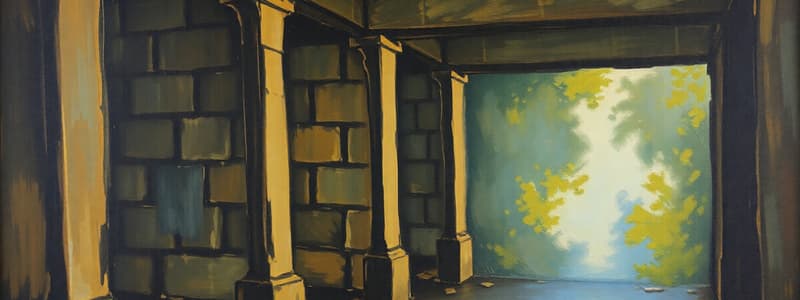Podcast
Questions and Answers
What are structural loads?
What are structural loads?
Structural loads are forces or other actions that cause stresses, deformations, or accelerations in a structure.
Which of the following is an example of a dead load?
Which of the following is an example of a dead load?
- Occupants
- Furniture
- Vehicles
- Self-weight of structural members (correct)
What causes Wind Loads?
What causes Wind Loads?
- Ground motion during earthquakes
- Roof slope
- Snow accumulation
- Wind pressure on building surfaces (correct)
What is the cause of seismic loads?
What is the cause of seismic loads?
What is the cause of Thermal Loads?
What is the cause of Thermal Loads?
What is the cause of Construction Loads?
What is the cause of Construction Loads?
What does load transfer involve?
What does load transfer involve?
What elements do slabs serve as?
What elements do slabs serve as?
What elements do beams transfer loads to?
What elements do beams transfer loads to?
Vertically oriented members transferring loads from beams to the foundation?
Vertically oriented members transferring loads from beams to the foundation?
What elements do Load-bearing walls transfer the loads to?
What elements do Load-bearing walls transfer the loads to?
What is the ultimate recipient of structural loads?
What is the ultimate recipient of structural loads?
Flashcards
Structural Loads
Structural Loads
Forces that cause stress, deformation, or acceleration in a structure.
Dead Load (DL)
Dead Load (DL)
Permanent, static forces on a structure.
Live Load (LL)
Live Load (LL)
Temporary or movable forces that vary in magnitude and location.
Wind Loads (WL)
Wind Loads (WL)
Signup and view all the flashcards
Snow Loads (SL)
Snow Loads (SL)
Signup and view all the flashcards
Seismic Loads (EL)
Seismic Loads (EL)
Signup and view all the flashcards
Thermal Loads
Thermal Loads
Signup and view all the flashcards
Construction Loads
Construction Loads
Signup and view all the flashcards
Load Transfer
Load Transfer
Signup and view all the flashcards
Superstructure Load Transfer
Superstructure Load Transfer
Signup and view all the flashcards
Slabs load
Slabs load
Signup and view all the flashcards
Two-way slabs
Two-way slabs
Signup and view all the flashcards
Beams load
Beams load
Signup and view all the flashcards
Columns Load
Columns Load
Signup and view all the flashcards
Load-bearing walls
Load-bearing walls
Signup and view all the flashcards
Substructure Load Transfer
Substructure Load Transfer
Signup and view all the flashcards
Foundations load
Foundations load
Signup and view all the flashcards
Soil load
Soil load
Signup and view all the flashcards
Columns
Columns
Signup and view all the flashcards
Superstructure
Superstructure
Signup and view all the flashcards
Foundations
Foundations
Signup and view all the flashcards
Soil
Soil
Signup and view all the flashcards
Walls
Walls
Signup and view all the flashcards
Construction Load
Construction Load
Signup and view all the flashcards
Thermal Load
Thermal Load
Signup and view all the flashcards
Seismic Load
Seismic Load
Signup and view all the flashcards
Wind Load
Wind Load
Signup and view all the flashcards
Dead Load - DL
Dead Load - DL
Signup and view all the flashcards
Live Load - LL
Live Load - LL
Signup and view all the flashcards
Structural Loads
Structural Loads
Signup and view all the flashcards
Study Notes
- Structural loads are forces or actions causing stresses, deformations, or accelerations in a structure.
- These loads are fundamental for the design and safety of buildings.
- Structural members must withstand expected forces under normal and extreme conditions.
Types of Loads on Structural Members
- Dead Load (DL)
- Live Loads (LL)
- Environmental Loads (LL)
- Other Loads (Thermal Loads, Construction Loads, etc.)
Dead Loads (DL)
- Dead loads are permanent, static forces acting on a structure.
- They include the self-weight of structural members like beams, columns, slabs, and fixed attachments such as walls, flooring, and finishes.
- Calculated based on the material density and volume.
Live Loads (LL)
- Live loads are temporary or movable forces with varying magnitude and location.
- Examples: occupants, furniture, equipment, and vehicles.
- Codes and standards specify live load values based on building use like residential, commercial, or industrial.
Environmental Loads
- Wind Loads (WL): Caused by wind pressure on building surfaces, dependent on wind speed, building height, and shape.
- Snow Loads (SL): Relevant in areas, based on snow accumulation and roof slope.
- Seismic Loads (EL): Arise from ground motion during earthquakes, governed by local seismic zone classifications and building response factors.
Other Loads
- Thermal Loads: Expansion or contraction due to temperature changes.
- Construction Loads: Temporary loads during construction activities.
Load Transfer in Buildings
- Structural members work together to transfer loads from the application point to the foundation and ground.
- Load transfer occurs through Superstructure Load Transfer and Substructure Load Transfer.
Superstructure Load Transfer
- Slabs: Horizontal elements distributing loads (live and dead) to beams with loads shared in two perpendicular directions in two-way slabs.
- Beams: Receive loads from slabs and transfer them to columns, designed to resist bending, shear, and deflection.
- Columns: Vertically oriented members transferring loads from beams to the foundation and subjected to axial forces, sometimes with bending in slender columns.
- Walls: Can be load-bearing or non-load-bearing elements, with load-bearing walls transferring roof and floor loads to the foundation.
Substructure Load Transfer
- Foundations distribute structural loads to the ground with types including shallow foundations (spread footings, mat foundations) and deep foundations (piles, caissons).
- Soil is the ultimate recipient of structural loads.
- The soil's bearing capacity resists excessive settlement or failure.
Studying That Suits You
Use AI to generate personalized quizzes and flashcards to suit your learning preferences.
Related Documents
Description
Explanation of structural loads: forces causing stress/deformation in structures, crucial for building design and safety. Covers dead loads (permanent, static forces), live loads (temporary, movable forces), and environmental loads.



